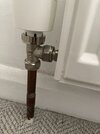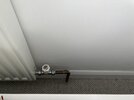Hi all,
I have recently replaced my TRVs on my radiators, but I have a strange problem now which occurs when one of the bedroom radiator TRVs shuts off when the central heating is running. When it does so, I get a loud vibrating noise (rapid almost like a machine gun noise) which is loudest where I have a towel rail in the adjoining shower room. I've attached a video below.
It is a two pipe system. I believe it has only started occurring as I now have TRVs that actually work and shut off this particular bedroom radiator when up to temp, as I cannot see that it is anything to do with the new TRV itself?
Any help much appreciated. If I turn off the towel rail (TRV on frost setting) the noise stops.
Thinking about it, I believe for whatever reason the TRVs on the bedroom radiators (not installed by me; previous owner presumably got someone in to do them) are on the return rather than flow. Is this likely to be the cause of the problem?
I have recently replaced my TRVs on my radiators, but I have a strange problem now which occurs when one of the bedroom radiator TRVs shuts off when the central heating is running. When it does so, I get a loud vibrating noise (rapid almost like a machine gun noise) which is loudest where I have a towel rail in the adjoining shower room. I've attached a video below.
It is a two pipe system. I believe it has only started occurring as I now have TRVs that actually work and shut off this particular bedroom radiator when up to temp, as I cannot see that it is anything to do with the new TRV itself?
Any help much appreciated. If I turn off the towel rail (TRV on frost setting) the noise stops.
Thinking about it, I believe for whatever reason the TRVs on the bedroom radiators (not installed by me; previous owner presumably got someone in to do them) are on the return rather than flow. Is this likely to be the cause of the problem?



